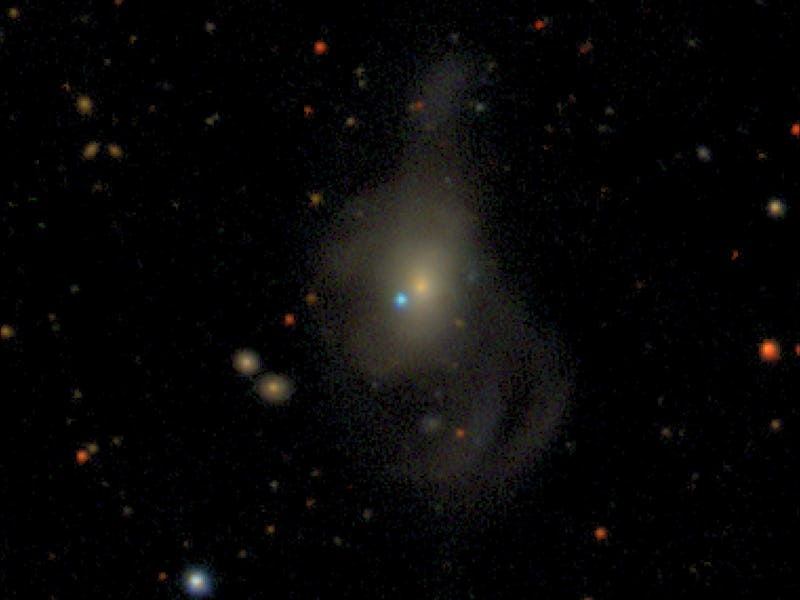Astronomers glimpse a rare flashing light from deep space
The rare flash was visible for a couple of days.

In December, 2019, astronomers spotted a strange kind of supernova in a nearby galaxy located 140 million light years away from Earth near the constellation Draco.
The explosive event marked the death of a white dwarf star, the most common type of star in the galaxy. However, what was uncommon, was the flash of ultraviolet light that accompanied the stellar funeral. The rare flash indicated that something inside the star was extremely hot, even though white dwarfs are notoriously cool.
Astronomers are not sure what produced the light flash, but further observations of the rare event will help them better understand what causes white dwarfs to explode in a supernova.
The findings are published Thursday in The Astrophysical Journal, and may give scientists insight into the elusive dark energy that dominates the universe.
As a star nears the end of its life, it runs out of fuel and essentially collapses under its own gravity. The death of a giant star results in a massive explosion witnessed across galaxies, a supernova.
Each supernova is unique, depending on the properties of the star itself. However, astronomers are quite familiar with white dwarf stars. These common types of stars decrease in temperatures as they age, becoming cooler and cooler with time.
Therefore, the flash of ultraviolet light is quite puzzling. UV light is caused by extreme heat, temperatures that are three to four times hotter than the Sun and most supernovae do not produce that kind of heat.
Adam Miller, astrophysicist at Northwestern University and lead author behind the new study, believes that the UV light is telling of something specific about the explosion of this particular white dwarf.
“These are some of the most common explosions in the universe,” Miller said in a statement. “But what’s special is this UV flash. Astronomers have searched for this for years and never found it."
The supernova appears as a small blue dot in the center of its host galaxy, located 140 light years away from Earth.
The team behind the new study came up with four different scenarios that may have caused this flash of light.
- The white dwarf star could have consumed a companion star, becoming so large and unstable that it exploded.
- Extremely hot radioactive material from the core of the star mixed in with its outer layer, causing it to increase in temperature.
- An outer layer of helium interacts with the carbon inside the star, causing a double explosion.
- Or finally that this was the merger of two white dwarf stars, causing a massive explosion.
Clues as to how the supernova occurred will be further revealed with time.
“As time passes, the exploded material moves farther away from the source. As that material thins, we can see deeper and deeper," Miller said. "After a year, the material will be so thin that we will see all the way into the center of the explosion.”
Further observations of the supernova explosion could provide astronomers with clues regarding dark energy. Although dark energy makes up around 68 percent of energy in the universe, it has never been directly observed since it's quite, well, dark. However, astronomers believe that it is the force of dark energy, acting as a counter to gravity, that accelerates the rate of expansion for the universe and they are not sure why.
Therefore, astronomers use the supernova explosions of white dwarfs to measure distances in the universe, acting as cosmic candles in the darkness.
Abstract: Early observations of Type Ia supernovae (SNe Ia) provide essential clues for understanding the progenitor system that gave rise to the terminal thermonuclear explosion. We present exquisite observations of SN 2019yvq, the second observed SN Ia, after iPTF 14atg, to display an early flash of emission in the ultraviolet (UV) and optical. Our analysis finds that SN 2019yvq was unusual, even when ignoring the initial flash, in that it was moderately underluminous for an SN Ia ( mag at peak) yet featured very high absorption velocities ( km s−1 for Si iiλ6355 at peak). We find that many of the observational features of SN 2019yvq, aside from the flash, can be explained if the explosive yield of radioactive 56Ni is relatively low (we measure ) and it and other iron-group elements are concentrated in the innermost layers of the ejecta. To explain both the UV/optical flash and peak properties of SN 2019yvq we consider four different models: interaction between the SN ejecta and a nondegenerate companion, extended clumps of 56Ni in the outer ejecta, a double-detonation explosion, and the violent merger of two white dwarfs. Each of these models has shortcomings when compared to the observations; it is clear additional tuning is required to better match SN 2019yvq. In closing, we predict that the nebular spectra of SN 2019yvq will feature either H or He emission, if the ejecta collided with a companion, strong [Ca ii] emission, if it was a double detonation, or narrow [O i] emission, if it was due to a violent merger.
This article was originally published on